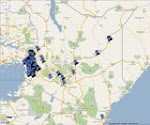Report by Wycliffe Osumba, submitted on 2010-06-29.
Aim
The aim of the project is to improve the people’s health situations through the dissemination of hygienic environmentally friendly sanitation technologies. Special attention is given to the reduction in water consumption, the aspect of recycling degradable waste from biomass as fertilizers to improve hygiene and health through clean toilets on institution and household level.
This month we had different follow - ups made as per the planned activities as follows:
1. Achievements
2. Problems
3. Way forward
4. Plan of action
Achievements
This month we had conducted the following training for communities, groups and institutions. The training was focusing the following areas:
1. Maintenance of the UDDTS
2. Destruction of the end products
3. Wages of the end products from UDDTS
4. Composting procedures
Club formation in schools I visited was formed and has the eco-san team, to support and sustain the project as one of the resources.
The schools had already realized the opportunities, strength, weaknesses, policies, mission, general objectives threats they have.
Mission
· Create and support the conservation of environment by fighting against the destruction of indigenous vegetation as a centre and focal point, the community and school work together.
· As a centre and focal point, the community and school work together.
· Sensitize pupils and community at large on the importance of conservation of the environment
· Transfer of knowledge to local community to promote Income Generation Activities (IGA)
· To amply the new technologies and knowledge acquired both as school and community
General objectives
The project is to provide sustainable development programme to the community through which cares and support the conservation of ecological sanitation and environmentally conservation.
Policies
· To increase income earning opportunities to both schools and communities.
· To conserve and sustain the environment.
· To transfer knowledge and new technology for developing efficient and sustainable education system.
· To provide required services to the pupils and the community on environmental, ecological, sanitation and agricultural education.
Strength
· Available of manpower
· Positive attitude of community members both pupils, teachers and communities
· Skilled staff on environmental conservation and ecological sanitation management.
Weakness
· Lack of modern technology and skills on biogas, usage of sunlight to produce power system
· Lack of sufficient information and enlightenment within the community
· Lack of resources to help in sustainability
Opportunities
· Availability of land (School garden)
· Availability of iron roof for water harvesting
· Skilled teachers to facilitate both pupils and communities
Threats
· Hostile and sometimes unpredictable climate
· Poor soil texture
· Tropical diseases and pest
· Destruction caused by animals and human being.
· Theft
Success indicators
· Community members and pupils have been sensitized in new methods and techniques of using eco-san product.
· Teachers and pupils have developed positive attitudes towards eco-san project.
· Community members are planting more trees to address the climate change.
Current activities
· Maize plantation are in place
· Planning to start horticultural garden in school.
· Eco-san team meetings.
Problems
· Lack of water for irrigation and hand washing because most schools do not have water supply system in place.
· Lack of stultified seeds for planting.
· Few eco san toilets constructed are not enough for both pupils and teachers; this makes work difficult to monitor who is to use the units.
· Communities are demanding eco san services in their homes because they have learnt the goodness of the units.
Community Activities
Most of the community groups are women groups with good structures in place.
1. Chair person
2. Secretary
3. Treasurer
4. Committee Members
5. Group Members
Most of the groups are legal groups, registered with the ministry of cultural and social services.
These groups have the project goals, problem statement, justification, objectives, activities and they meet monthly for reporting purposes.
Most of the groups visited are concerned with the environmental conservation after they had gone through training of different training for income generation activities.
Due to poor soil condition many pit latrines had been collapsing during the rainy season. And affected many called permanent toilets collapsed.
Problems
The community does have the following problems during the visit meeting
Most of the communities visited ecological sanitation is still a big problem that means lack of the following in place:
· Dish racks
· Composting pit
· Rubbish pit
· Bathroom
· Water tanks for roof catchment
Due to the above, most of women and girl child walk a long distance to fetch water from rivers; lakes which take some people 20KM both from river to home. This water is polluted because all the laundry and bathing are still practiced along the water sources.
Achievements
1. Most of the places I visited had already using the eco san unit.
2. Urine is in use for agricultural purposes.
Way forward
· Training the needy schools on tree nursery management.
· Horticultural farming.
· Community training on how to manage community groups.
· Follow ups of the unfinished construction.


